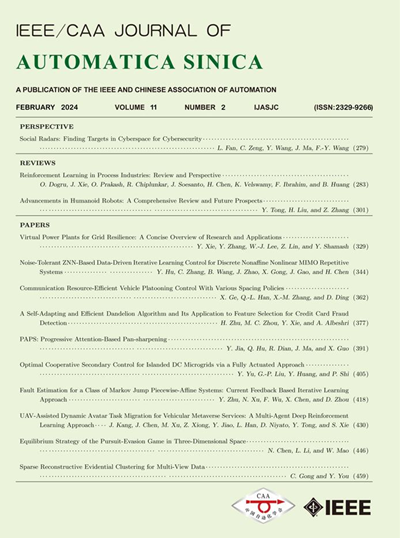分布式自适应二阶潜因分析模型
IF 15.3
1区 计算机科学
Q1 AUTOMATION & CONTROL SYSTEMS
引用次数: 0
摘要
亲爱的编辑,这封信介绍了一种分布式自适应二阶潜因(DAS)模型,用于解决高维和不完整数据表示的问题。与一阶优化器相比,二阶优化器在处理非凸优化问题时具有更强的求解能力,从而在从高维和不完整数据中提取能很好地代表已知信息的潜在因子(LFs)方面获得更好的性能。然而,由于 LF 模型的参数数量庞大,传统的二阶优化器在利用 LF 模型的曲率信息方面效率低下。为了减少计算开销,人们倾向于采用一种依赖于无赫塞斯优化的非精确二阶方法。然而,这种方法需要仔细协调各组成部分,耗时较长,在实际应用中并不可行。为解决上述问题,DAS 模型利用曲率信息与黑森向量嵌入式非精确二阶优化器,并将其嵌入到分布式、多阶段和多精英学习粒子群优化(DM2PSO)框架中,以实现高效的超参数适应和性能增益。实验结果表明,DAS 模型在估计现实世界应用中几个高维和不完整数据集的缺失数据时,性能优于几个最先进的模型。本文章由计算机程序翻译,如有差异,请以英文原文为准。
A Distributed Adaptive Second-Order Latent Factor Analysis Model
Dear Editor, This letter presents a distributed adaptive second-order latent factor (DAS) model for addressing the issue of high-dimensional and incomplete data representation. Compared with first-order optimizers, a second-order optimizer has stronger ability in approaching a better solution when dealing with the non-convex optimization problems, thus obtaining better performance in extracting the latent factors (LFs) well representing the known information from high-dimensional and incomplete data. However, a traditional second-order optimizer are inefficient in exploiting the curvature information of an LF model due to its large number of parameters. In order to reduce the computational overhead, an inexact second-order method relying on the Hessian-free optimization is preferred. However, this method requires careful coordination of its components, which is time-consuming and impractical for real applications. To address the above issues, the DAS model leverages the curvature information with a Hessian-vector-incorporated inexact second-order optimizer and embeds it into a distributed, multi-phase, and multi-elitist learning particle swarm optimization (DM2PSO) framework for efficient hyper-parameters adaptation and performance gain. Experimental results demonstrate that the DAS model outperforms several state-of-the-art models in estimating missing data on several high-dimensional and incomplete datasets from real-world applications.
求助全文
通过发布文献求助,成功后即可免费获取论文全文。
去求助
来源期刊

Ieee-Caa Journal of Automatica Sinica
Engineering-Control and Systems Engineering
CiteScore
23.50
自引率
11.00%
发文量
880
期刊介绍:
The IEEE/CAA Journal of Automatica Sinica is a reputable journal that publishes high-quality papers in English on original theoretical/experimental research and development in the field of automation. The journal covers a wide range of topics including automatic control, artificial intelligence and intelligent control, systems theory and engineering, pattern recognition and intelligent systems, automation engineering and applications, information processing and information systems, network-based automation, robotics, sensing and measurement, and navigation, guidance, and control.
Additionally, the journal is abstracted/indexed in several prominent databases including SCIE (Science Citation Index Expanded), EI (Engineering Index), Inspec, Scopus, SCImago, DBLP, CNKI (China National Knowledge Infrastructure), CSCD (Chinese Science Citation Database), and IEEE Xplore.
 求助内容:
求助内容: 应助结果提醒方式:
应助结果提醒方式:


